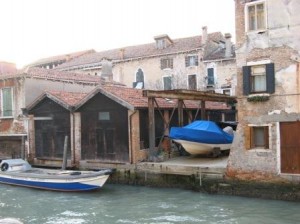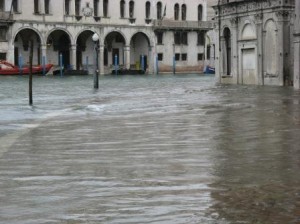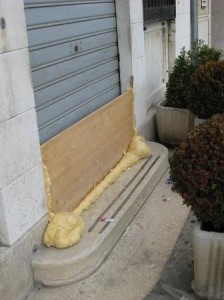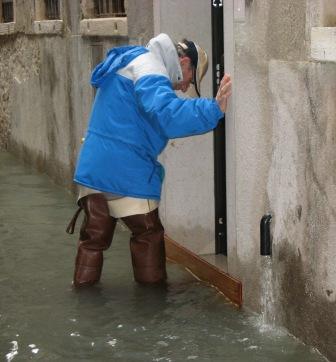Here are two elements of high water which aren’t usually — perhaps not ever — mentioned, much less interpreted, in the typical story, the kind that likes using emotional words like “invade.” ( As in, “The water invaded the city.” Stormed the battlements. Conquered the kingdom, wrought havoc, death and destruction, setting towns to the torch and sending everyone into slavery. You know, the usual high-water scenario.) Where was I.

One is what the numbers actually mean. Venice does not float like a lily-pad at sea level. The lowest area in the city, the Piazza San Marco, is already 80 cm above the water’s surface when the water is at mean sea-level. Therefore any height that’s reported isn’t as high as it sounds if we were just standing on a street somewhere, measuring upwards from our feet, because the starting number isn’t zero.
Example: 110 cm converts to three and a half feet, which sounds scary. But someone standing in the Piazza San Marco will have water reaching up only 30 cm from their feet, or roughly just below their knees (11 inches). Someone elsewhere in the city might well not have it even that high. Or at all. Because of Point Number Two.

Point Number Two: Headlines blaring “VENICE IS FLOODED” imply that the entire city, all three square miles of it, is going under for the third time. In fact, a tide up to 110 cm will dampen 14 percent of the city. Not a huge percentage, I think one must admit. Up at 140 cm (the relatively rare Code Red, “exceptional high water”), it covers almost 50 percent of the city, which is more impressive, except that the frequency of a tide this high is fairly low — five times in the ten years between 2000 and 2010. And still, one isn’t referring to every square inch of Venice. Amost half of the city is still high and dry.
For all of Venice to be flooded, the tide would have to rise well beyond 200 cm (the epochal acqua alta of November 4, 1966 reached 194 cm). The city’s tide office doesn’t estimate above 200 cm, at which level 86 percent of the city would be underwater. I don’t say that would be entertaining, but it would be so rare that I’d suggest saving the doomsday vocabulary for it, and not waste the drama on more mundane tidal events.

Our little hovel is safe up to the three-tone level. At four tones, it’s time to take the tarps off the lifeboats. We discovered that last December 1 at about 9:15, when the water reached the four-tone level and began to slide under our front door. Then I discovered it was also coming through a fissure in the wall under the kitchen sink, as well as up through a fissure in the stone flooring. That was more exciting than almost anything I can remember. So please don’t suppose that my viewpoint is the result of my not having to worry about water under the bed. I just want to recalibrate the popular perception of this phenomenon. Obnoxious. Not catastrophic.
We have a calendar, on sale at any newsstand, which traces the predicted tide levels each day of the year. But those are only estimates based on what’s normal. For more timely updates, I check the data on the city’s Tide Center website. You can also sign up to be alerted of the rising tide via text message (SMS) on your cell phone.
All these advisories are what make it really hard for me to feel sincerely sorry for anyone who might find that water had caused any damage to goods or appliances. It’s not like it comes like a thief in the night.
I leave you with the key phrase which ought to simplify the whole business if you’re here long enough to need to know it: Hip waders. Just do it.

